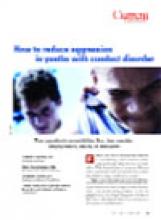I am rebutting “How to reduce aggression in patients with conduct disorder” (Current Psychiatry, April 2004).
A 15-year-old ended his first two visits with me under police custody and was committed both times. After the first commitment, his grandmother filed a petition alleging unruly/delinquent behavior, and a judge ordered the boy to take his prescribed mood stabilizers. That was necessary because the hospital psychiatrist had determined that the boy was not mentally ill and that his grandmother needed parenting classes. The youth’s original diagnosis—conduct disorder and oppositional-defiant disorder (ODD)—contradicted my diagnosis: bipolar disorder, mixed.
During the second hospitalization, a psychiatrist diagnosed the youth as having attentiondeficit/hyperactivity disorder (ADHD). The doctor prescribed methylphenidate and oxcarbazepine, but the patient’s guardian did not consent to the medications.
Facing a sentence at the county juvenile detention center, the youth started taking olanzapine, 10 mg at bedtime, and lamotrigine, 25 mg bid titrated to 50 mg bid, as I had prescribed. His grandmother says that he no longer exhibits defiant behavior. At his third visit, he shook my hand and said, “Thank you for finding the right medications for me.”
I have seen hundreds of similar cases over 10 years. To paraphrase a colleague, diagnosing somebody with conduct disorder or ODD is like diagnosing a patient with a runny nose after a thorough emergency room examination.
I applaud the American Association of Community Psychiatry’s efforts to urge the American Psychiatric Association (APA) to abolish the conduct disorder diagnosis. I also support the many researchers who are requesting elimination of conduct disorder and ODD. These are not real and specific diagnoses but are alleged syndromes that express several conditions.
Manuel Mota-Castillo MD
Orlando, FL
Dr. Malone responds
It is hard to assess Dr. Mota-Castillo’s case based on the information he provided. Still, one would not refute any psychiatric syndrome by citing a single case.
Most psychiatric disorders are syndromes and affect heterogeneous groups. This is true for disorders that are more prevalent in adults—such as schizophrenia and mania—and for those that present in childhood and adolescence—such as conduct disorder, ODD, and ADHD. Heterogeneity within disorders is no doubt related to underlying individual differences in genetics and environment and contributes to differences in symptom expression and treatment response.
Dr. Mota-Castillo did not present symptoms listed under DSM-IV-TR, so it is unclear how the patient was diagnosed. Diagnoses:
- are one clinician’s impression or the consensus of several clinicians
- are based on one patient encounter or ongoing treatment
- occur with or without input from other sources, such as parents and school
- are made with or without validated structured interviews.
Conduct disorder and ODDare part of DSM diagnostic nomenclature,1 and the APA and American Academy of Child and Adolescent Psychiatry recognize both disorders. Reducing aggression associated with either disorder has long been the most common reason for psychiatric consultation in children.2
Also, Dr. Mota-Castillo prescribed olanzapine and lamotrigine, apparently for simultaneous use. The main point of our case was to discourage polypharmacy—something most experts agree should be avoided3 —by carefully starting one drug before adding a second. When a child receives two drugs at once, we cannot know the effect of either.
In the 15-year-old’s case, as often happens, the prescribed treatment might not have changed the symptoms; some symptoms remit spontaneously.
Nor does drug response clarify diagnosis. For example, both bipolar disorder and aggression in conduct disorder (and in many other conditions) may respond to an antipsychotic.4 Lithium and other treatments for mania have been shown to reduce severe aggression in nonmanic children and adolescents with conduct disorder.5,6
Richard P. Malone, MD
Associate professor
Eastern Pennsylvania Psychiatric Institute
Drexel University College of Medicine
Philadelphia, PA
- American Psychiatric Association. Diagnostic and Statistical Manual of Mental Disorders (4th ed-rev). Washington, DC: American Psychiatric Association, 2000.
- Kazdin AE. Conduct disorders in childhood and adolescence, vol. 9: developmental clinical psychology and psychiatry series. Newbury Park, CA: Sage Publications, 1987.
- Pappadopulos E, Macintyre JC II, Crismon ML, et al. Treatment recommendations for the use of antipsychotics for aggressive youth (TRAAY): Part II. J Am Acad Child Adolesc Psychiatry 2003;42(2):145–61.
- Malone RP, Delaney MA. Psychopharmacologic interventions in children with aggression: neuroleptics, lithium, and anticonvulsants. In: Coccaro EF (ed). Aggression: assessment and treatment.New York: Marcel Dekker, 2003:331–49.
- Malone RP, Delaney MA, Luebbert JF, et al. A double-blind placebo-controlled study of lithium in hospitalized aggressive children and adolescents with conduct disorder. Arch Gen Psychiatry 2000;57(7):649–54.
- Campbell M, Adams PB, Small AM, et al. Lithium in hospitalized aggressive children with conduct disorder: a double-blind and placebo-controlled study. J Am Acad Child Adolesc Psychiatry 1995;34(4):445–53.


